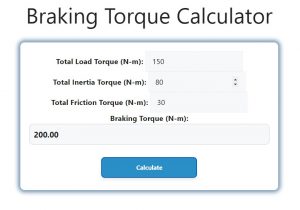About Braking Torque Calculator (Formula)
The Braking Torque Calculator is a vital tool in engineering and mechanics, allowing professionals and hobbyists alike to calculate the braking torque required for various systems. Braking torque plays a crucial role in the design and operation of machines, vehicles, and other mechanical systems where controlled stopping is necessary. Understanding how to calculate and apply braking torque helps ensure safety, efficiency, and effectiveness in mechanical applications.
Formula
The formula for calculating braking torque is:
Braking Torque = Total Load Torque + Total Inertia Torque – Total Friction Torque
Where:
- Total Load Torque is the torque required to overcome the load.
- Total Inertia Torque accounts for the inertia of moving parts.
- Total Friction Torque includes the resistance caused by friction in the system.
How to Use
To use the Braking Torque Calculator, follow these simple steps:
- Gather Required Data: Collect values for total load torque, total inertia torque, and total friction torque from your system specifications.
- Insert Values into the Formula: Substitute the gathered values into the formula:
Braking Torque = Total Load Torque + Total Inertia Torque – Total Friction Torque. - Perform the Calculation: Carry out the arithmetic to find the braking torque needed for your application.
- Analyze the Results: Use the calculated braking torque to determine if your braking system is adequate for your specific requirements.
Example
Let’s walk through an example to illustrate how to calculate braking torque.
- Total Load Torque: 150 Nm
- Total Inertia Torque: 80 Nm
- Total Friction Torque: 30 Nm
Using the formula:
Braking Torque = Total Load Torque + Total Inertia Torque – Total Friction Torque
Braking Torque = 150 Nm + 80 Nm – 30 Nm
Braking Torque = 200 Nm
In this example, the required braking torque would be 200 Nm, indicating the amount of torque needed to safely stop the system.

FAQs
- What is braking torque?
Braking torque is the torque exerted by the brakes to slow down or stop a moving system. - Why is calculating braking torque important?
Properly calculating braking torque ensures that braking systems are effective and can safely stop machinery or vehicles. - What factors affect braking torque?
Factors include total load torque, inertia, friction in the system, and the type of braking mechanism used. - How can I measure total load torque?
Total load torque can be measured using torque sensors or calculated based on the load and distance from the pivot point. - What is total inertia torque?
Total inertia torque accounts for the resistance to motion caused by the mass and acceleration of rotating parts. - What role does total friction torque play?
Total friction torque represents the resistance caused by friction in the braking system, impacting the overall braking effectiveness. - Can braking torque be negative?
No, braking torque should always be a positive value, as it represents the force needed to decelerate a system. - What happens if braking torque is insufficient?
Insufficient braking torque can lead to ineffective braking, potentially causing accidents or mechanical failures. - How often should I calculate braking torque?
It is advisable to calculate braking torque whenever modifications are made to the system or when new components are added. - What tools are available to calculate braking torque?
Many engineering software tools and online calculators are available for accurately calculating braking torque. - What is the difference between static and dynamic braking torque?
Static braking torque refers to the torque required to stop a stationary object, while dynamic braking torque is used to stop a moving object. - How do friction materials affect braking torque?
The type of friction material used in braking systems can significantly influence the total friction torque and, consequently, the braking torque required. - What is the effect of speed on braking torque?
As speed increases, the required braking torque generally increases due to higher inertia and load dynamics. - Can braking torque be adjusted?
Yes, braking torque can be adjusted by changing the braking system components, such as using different friction materials or adjusting the brake design. - How does temperature affect braking torque?
Elevated temperatures can alter the performance of braking materials, affecting friction coefficients and overall braking torque. - What is the relationship between braking torque and safety?
Adequate braking torque is crucial for safety, as it ensures reliable stopping power in various operational conditions. - Are there industry standards for braking torque calculations?
Yes, various industry standards and guidelines exist, depending on the application, such as automotive or industrial machinery. - How can I improve the efficiency of my braking system?
Regular maintenance, using quality materials, and recalculating braking torque after modifications can enhance braking efficiency. - Is it possible to overestimate braking torque?
Overestimating braking torque can lead to unnecessary costs and weight in the braking system, affecting overall performance. - What should I do if my braking torque calculations show inadequate values?
If calculations indicate insufficient braking torque, consider upgrading your braking system, modifying load conditions, or consulting with a mechanical engineer.
Conclusion
The Braking Torque Calculator is an essential resource for engineers and technicians involved in designing and maintaining mechanical systems. By using the formula Braking Torque = Total Load Torque + Total Inertia Torque – Total Friction Torque, users can accurately determine the required braking torque for their applications. This knowledge is vital for ensuring safety, reliability, and efficiency in systems that require controlled stopping. Regularly calculating and analyzing braking torque will help optimize braking performance and enhance overall system functionality.